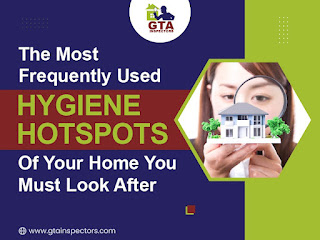Be Careful About The Most Commonly Used Hygiene Spots In Your Home
You must be aware of the areas on your property that require regular attention to prevent insect infestation. Many corners of our properties go unnoticed and can contaminate the air around us. If you want to keep your property in good condition, you should be aware of these areas. You can identify hygiene issues on your property by reading the blog below.
You should be aware that hygiene spots are vital areas in a home that need to be maintained regularly. This will keep your family safe from any health problems. With quality home inspection services, you can quickly find out about any property defects.
The Most Common Hygiene Hotspots in Your Home
Kitchen Countertop -
Kitchen countertops are prone to getting dirty quickly because of liquid spills, dust, and slime that can spread when cutting up raw meat, fruit or vegetables. Wash your kitchen counter regularly with warm, soapy water. After cleaning the counter with isopropyl ethanol, disinfect it by letting it sit for a while. Last step is to rinse it with water, then wipe it dry.
Dish Sponge
The dish sponge that is used to clean utensils contains the most bacteria and germs. To maintain your kitchen's hygiene, it is best to clean the sponge after you have washed the utensils. The sponge can be cleaned with white vinegar or lemon juice. Both methods will disinfect it thoroughly. Replace your cleaning sponge at least every two or three months.
Kitchen and bathroom faucets
As we touch them regularly, kitchen and bathroom faucets can become contaminated. Regularly clean them using soapy water with a sponge. Wipe your faucets with a soft, damp cloth dipped into diluted vinegar.
Handles and Switches
You must keep your monica geller property clean by cleaning the areas that are most used, such as cabinets, doorknobs and switches. These areas can be disinfected twice or once a month. During a property inspection, switches are checked primarily. Regular maintenance will make your property appear neat and attractive to potential buyers.
Shower Area
Shower areas are the most contaminated part of your home. Shower areas need to be treated with extreme care as they can easily become contaminated by soap, scum and body oils. Stagnant water can become a breeding ground for bacteria, mould and fungi. The toilet area can be disinfected with a solution of hot water and distilled white vinegar. Use a sponge or soft brush to clean tiles and grout with the solution.
Toothbrush Holder
The holders hold your toothbrushes and tooth cleansers. They are infected by many bacteria that hide within. Bacteria can develop in the container as we place our wet brushes on the stand. The holders can hide a variety of airborne bacteria. The holders of toothbrushes should be washed twice a week in warm soapy-water. It is also important to replace the toothbrushes regularly.
Kitchen Cabinets -
It is important to clean the handles, as well as the inner cabinets and doors. Remember to clean utensils correctly. Bacteria can grow in locked cabinets. Touch your cabinets only with clean hands. Regular wiping will help to maintain hygiene.
Don't forget to regularly sanitize your hands and wash them.
Focus on these hygiene areas to protect your home from bacteria and pathogens. By following the above guidelines, you can reduce contamination on your property. This includes washing your hands, sanitizing hygiene spots and changing elements regularly. You will have a difficult time sanitizing your property if you ignore these tips.
Our certified property inspectors are experts at identifying weak points in your property.


Comments
Post a Comment